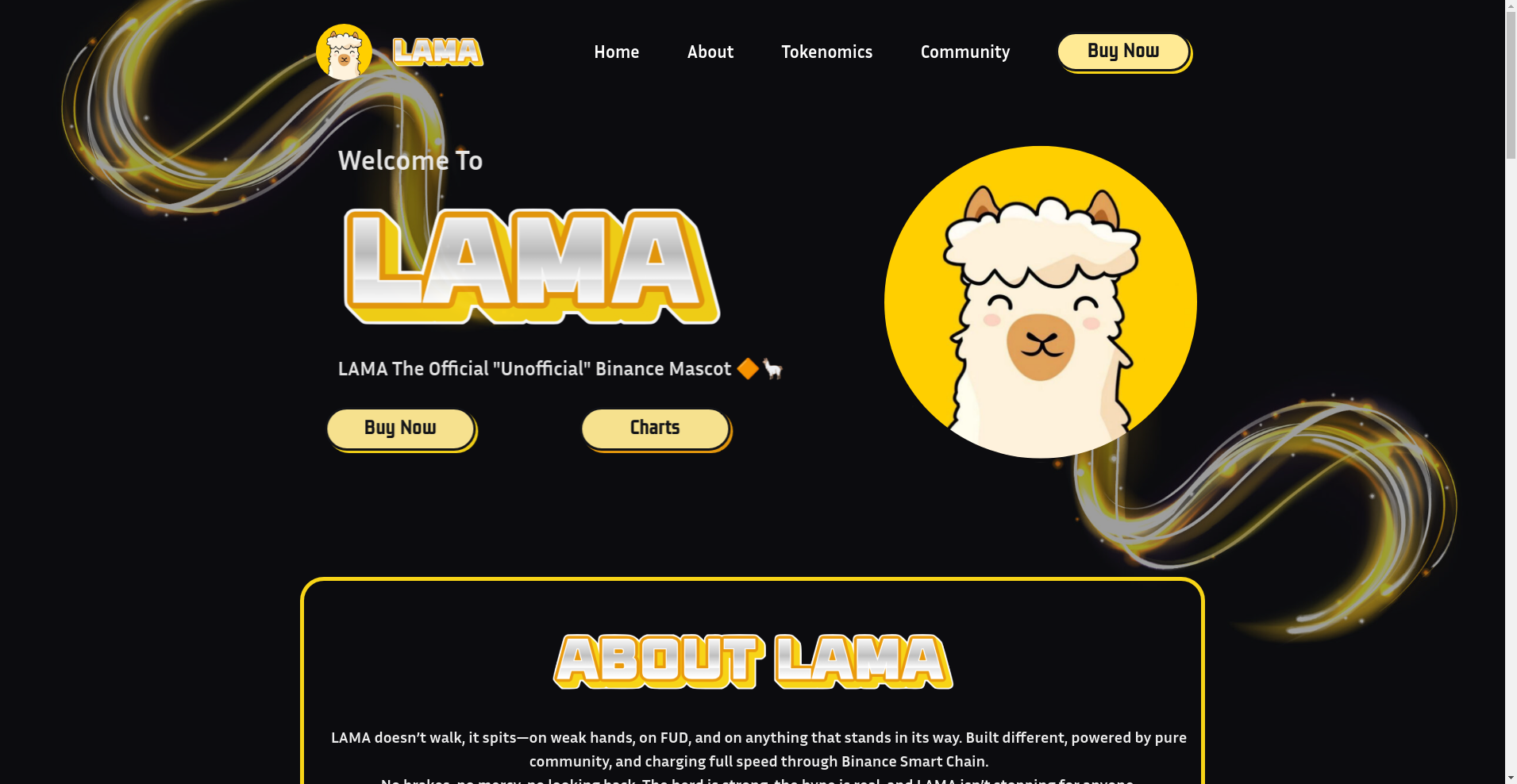Lama ($LAMA) Review: A Data-Driven Look at Its Legitimacy, Risks, and Long-Term Potential

What Is Lama: An Introduction
Lama (ticker: $LAMA) is a community-oriented cryptocurrency project built on the Binance Smart Chain (BSC). Marketed as the "Unofficial Binance Mascot," Lama adopts a bold, aggressive branding style that emphasizes resilience and defiance against market negativity, such as FUD (fear, uncertainty, doubt) and weak hands.
The project positions itself as a token powered primarily by its community, featuring a straightforward approach to buying and engaging with its ecosystem. Its core claims include a fixed total supply of 420 million tokens, a 5% transaction tax, and mechanisms aimed at promoting growth, marketing, and buyback operations. Despite its relatively simple premise, the project's claims and presentation warrant a thorough, impartial analysis of its legitimacy and potential risks, especially when considering common blockchain project risks.
The Team and Vision Behind Lama
Based on available information, Lama's development team presents itself with minimal transparency. The primary founder listed is Crypto BadrHD, but there is no detailed background, LinkedIn profiles, or public credentials provided to substantiate the team's expertise or experience in blockchain development or project management. This lack of transparency is a common concern in assessing the credibility of such projects, highlighting the importance of understanding the risks of anonymous teams in crypto.
While the project states that its contract has been renounced — which is generally seen as positive for decentralization and security — there is limited detail on post-launch development plans or ongoing governance structures. Its roadmap appears to center around community engagement and marketing efforts, with key milestones not publicly elaborated beyond basic tokenomics and initial deployment. Nonetheless, the project's roadmap seems confined to typical token promotion rather than technological innovation or ecosystem expansion. Understanding the validity of project roadmaps is crucial in these scenarios.
- Launch of token on Binance Smart Chain with a fixed supply
- Renouncement of contract (implying decentralization)
- Liquidity locked with multi-month extensions
Given the absence of detailed team credentials and a clear development trajectory, the ability of Lama to deliver on more ambitious future promises remains uncertain. The project appears to focus heavily on hype and community building rather than demonstrable innovation or long-term strategic plans.
Assessing the Security and Integrity of Lama
This security and trust assessment is based on the Cyberscope audit report submitted for the Lama project. The audit is a critical data point, as it provides an external review of the project's smart contract security features and potential vulnerabilities. It's vital to know how to decode these audit reports.
According to Cyberscope, Lama's smart contract received a high security score, approximately 94.82%. The report indicates that the contract has been reviewed for critical vulnerabilities, with most standard security best practices satisfied. Standard features such as ownership renouncement and liquidity locking are noted, which typically enhance security and reduce centralized control risks. This high score suggests a robust smart contract, aligning with the findings in other smart contract vulnerability explanations.
- High security score (~94.82%) suggests sound smart contract coding
- No apparent critical vulnerabilities or critical high-risk issues identified
- Ownership has been renounced, reducing central control risks
- Audit's focus was primarily on token contract security, not broader ecosystem audits
While the high score supports a degree of technical robustness, it is important to recognize that the audit covers only the smart contract security aspect. It does not address other potential risks such as centralization of control beyond the contract, team malpractices, or off-chain vulnerabilities. Moreover, with only one main audit source, there is limited independent verification of the project's overall security posture. For projects on BSC, it's also noteworthy to understand common Binance Smart Chain project failures.
Investors should interpret this audit as a positive indicator of technical soundness for the smart contract itself but remain cautious regarding the broader project governance and operational transparency.
A Breakdown of Lama Tokenomics
The tokenomics of Lama ($LAMA) lays the foundation for its economic model, designed to support growth and community engagement. Analyzing these figures helps to understand potential inflationary or deflationary pressures and the long-term viability of the project. Understanding tokenomics best practices is essential for any crypto investor.
- Total Supply: 420,000,000 LAMAS
- Initial Price: Approximately $5.07e-6 (or about 0.00000507 USD), suggesting a very low entry point for new investors
- Transaction Tax: 5% on each transfer, allocated for marketing, development, and buybacks (a common structure on BSC, see BSC project tokenomics analysis)
- Token Distribution: Specific breakdowns are not publicly detailed; however, the contract is renounced, and liquidity is locked, indicating a move towards decentralization
- Vesting & Locking: Liquidity tokens locked for extended periods, reducing immediate market dumps
- Utility: Primarily a community-driven meme-like token with marketing and promotional use cases
The fixed supply model prevents inflation; however, the 5% transaction fee may introduce sell pressure over time if liquidity or trading volume declines. The absence of detailed allocation for team, early investors, or reserves poses potential concerns about future sell-offs or centralization of token holdings. The token's utility appears mainly centered on community engagement rather than functional use cases or ecosystem expansion, which may limit its long-term sustainability. The differences between meme token utility versus hype are particularly relevant here.
Understanding the economic incentives and potential risks tied to tokenomics suggests that Lama's model is heavily reliant on hype, community support, and ongoing marketing efforts to maintain value, rather than inherent technological advantages or revenue-generating features.
Assessing Lama's Development and Ecosystem Activity
Analyzing Lama's development activity involves reviewing its recent GitHub commits, community engagement, and official updates. However, in this case, there appears to be limited public development activity or advanced ecosystem tools beyond initial launch announcements.
The project's website and social media accounts — notably the Telegram and X (Twitter) channels — have minimal evidence of active development updates or technical milestones beyond basic marketing pushes. The presence of a detailed buying guide, marketing claims, and community-driven merchandise suggest a focus on hype rather than ongoing technological innovation. This lack of development is a common pitfall for many Web3 projects.
Community activity, measured through the Telegram membership (currently around 123 members) and community scores (around 35 out of 100, per Cyberscope), indicates that genuine engagement may be limited. The community score, a relative indicator of active participation and credibility, remains quite low, as detailed in our guide on community scores in crypto project evaluation, reflecting a possibly speculative or niche following rather than a robust user base.
Overall, the development activity appears to be primarily marketing-led, with little evidence of continuous code development or ecosystem expansion. This could suggest that Lama’s future growth hinges on maintaining hype rather than technological progress.
The Fine Print: Analyzing Lama's Terms
Reviewing Lama’s publicly available documentation and website does not reveal any particularly unusual legal clauses or disclaimers. The project emphasizes decentralization via contract renouncement and liquidity locking as security measures, but there is limited legal or regulatory information provided. Investors should always be wary of projects lacking robust legal frameworks, especially those that may resemble common red flags in blockchain projects.
No specific clauses related to investor protections, dispute resolutions, or comprehensive legal frameworks are readily apparent. There is also no mention of audits beyond the Cyberscope smart contract review, and no disclosures regarding team jurisdiction or licensing.
Potential risks include the lack of detailed legal safeguards for investors and reliance on community and hype-driven growth. The project's aggressive branding and promotional language should encourage cautious scrutiny, especially considering that many similar meme tokens turn out to be scammers or pump-and-dump schemes. Understanding meme coin success factors and pitfalls is crucial for managing these risks.
Final Analysis: The Investment Case for Lama
Taking into account all available data, Lama ($LAMA) appears to be a high-risk, community-driven token primarily fueled by hype and aggressive branding. Its smart contract has undergone an audit that indicates robust security features, and its liquidity is locked, which are positive signs for technical security and decentralization. However, critical gaps lie in transparency about the team, roadmap, and ongoing development efforts. Evaluating meme token valuation metrics can help gauge its market position.
The project’s economic model is simple, with a fixed token supply and a transaction tax that incentivizes marketing efforts. The low market cap (~$2,151) and community score suggest limited adoption and engagement, which could lead to high volatility and speculative trading behavior. The lack of sustained development activity further diminishes its prospects for long-term stability or technological innovation.
-
Pros / Strengths
- High smart contract security score (approx. 94.82%)
- Liquidity locked, contract renounced, reducing centralized control risks
- Clear total supply with straightforward tokenomics
- Transparent and detailed purchase instructions on the official website
-
Cons / Risks
- Limited transparency about team credentials and governance (see risks of anonymous teams)
- Low community engagement and social media activity
- Heavy reliance on hype, with no substantial technological innovation
- Potential for market manipulation due to small market cap and low liquidity (liquidity and trading volume are key indicators)
- Lack of further ecosystem development or prominent use cases
- Possible vulnerability to pump-and-dump schemes typical of meme tokens
In conclusion, Lama's present form suggests it is a high-risk speculative asset rather than a project with sustainable growth or technological superiority. Investors should conduct thorough due diligence, recognize the inherent volatility, and approach with caution, especially given the project's community-focused yet opaque operational profile. As always, consider your risk tolerance carefully before engaging with such projects.

Olivia Lewis
Sociotechnical Systems Analyst
I analyze the intersection of social networks and blockchain systems. I use data to expose how scammers manipulate communities with bots, FUD, and engineered hype.
Similar Projects
-
BitChain (1-bitch)
Crypto Scam Checker Review: Is BitChain (1-bitch) a Scam or Legit Project?
-
ChikoToken
ChikoToken Review: Scam or Legit Crypto? Scam Check & Legitimacy Analysis
-
RWT Token
Comprehensive Review of RWT Token: Is This Crypto Project a Scam or Trustworthy?
-
Xocolatl Finance
Xocolatl Finance Review | Crypto Scam Checker & Project Scam Review
-
My Bro
My Bro Review: Crypto Project Scam Checker & Risk Analysis | Is $BRO Legit?